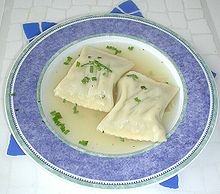- Maultasche
-
Maultaschen (singular
 Maultasche (help·info)) are a Swabian (Baden-Württemberg, Germany) specialty food, consisting of an outer layer of pasta dough with a filling traditionally made of minced meat, smoked meat, spinach, bread crumbs and onions and flavored with various herbs and spices (e.g. parsley and nutmeg). Similar in appearance to Italian ravioli, Maultaschen are usually larger, however, each Maultasche being about 8-12 cm (3-5 inches) across.
Maultasche (help·info)) are a Swabian (Baden-Württemberg, Germany) specialty food, consisting of an outer layer of pasta dough with a filling traditionally made of minced meat, smoked meat, spinach, bread crumbs and onions and flavored with various herbs and spices (e.g. parsley and nutmeg). Similar in appearance to Italian ravioli, Maultaschen are usually larger, however, each Maultasche being about 8-12 cm (3-5 inches) across.Maultaschen are traditionally eaten either geröstet (cut into slices and fried in a pan with onions and scrambled eggs) or in der Brühe (simmered in vegetable broth), or geschmälzt (dressed with butter and onions), usually with potato salad.
On Maundy Thursday and Good Friday, Maultaschen are a traditional dish in Swabia, because the meat is concealed under the pasta dough and cannot be seen by God. Therefore they have earned the nickname "Little Cheaters on God" (Swabian "Herrgottsbescheißerle").
Contents
Origin and Etymology
Various stories are told about the origin of Maultaschen although there is hardly evidence for one or the other.
- Maultaschen are rumored to have been invented by monks of the Maulbronn monastery to conceal the fact that they were eating meat during lent. The monks hid the meat inside of the Maultaschen, believing that God couldn't see it that way. (This is reflected in the humorous alternative Swabian name Herrgottsbescheißerle (roughly: "little ones to cheat on the Lord")
- Maultaschen could derive from the words "Maultatzen" or "Maultatschen" which is antiquated for a slap in the face. Thus the name could refer to the similarity between a swollen cheek and a Maultasche
- A cook book from 1794 contains several recipes for Maultaschen, but these are recipes for sweet desserts.[1]
- The compound word "Maultaschen" comes from the word "Maul" which means the mouth of an animal and "tasche" which means bag. Maultaschen literally means "feedbags" as if for livestock, and is probably named for its appearance.
Cultural significance
On October 23, 2009, the Gazette of the European Communities[2] announced that "Schwäbische Maultaschen" or "Schwäbische Suppenmaultaschen (g.g.A.)" are recognized as a "regional specialty", thus marking its significance to the cultural heritage of Baden-Württemberg. Just as importantly, this means that genuine Maultaschen have to be produced in Swabia, Baden-Württemberg, (German Federal State) or the Swabian speaking areas of Bavaria.[3]
See also
References
- ^ Allgemeine Küchenlexicon für Frauenzimmer. II. Th. Leipzig 1794. Col. 124–125
- ^ 23.10.2009 DE Amtsblatt der Europäischen Union L 278/5; VERORDNUNG (EG) Nr. 991/2009 DER KOMMISSION vom 22. Oktober 2009. [1]
- ^ shortnews.de, German article accessed 05-01-10.
Literature
- Dierig, Carsten (2009-02-09). "Ein schwäbisches Nationalgericht erobert das Kühlregal" (in German). Die Welt (Axel Springer AG). http://www.welt.de/welt_print/article3170731/Ein-schwaebisches-Nationalgericht-erobert-das-Kuehlregal.html. Retrieved 2009-02-09.
American cuisine Latin AmericaAsian cuisine East AsiaChinese: Baozi · Ci fan tuan · Dim sum · Fun guo · Har gow · Hujiao bing · Jau gok · Jiaozi · Lo mai gai · Shengjian mantou · Shumai · Siopao · Suanla chaoshou · Tang bao · Tangyan · Taro dumpling · Wonton · Xiaolongbao · Zhaliang · Zongzi · Other: Akashiyaki · Buuz · Dango · Khuushuur · Mandu · Mandugwa · Manduguk · Mitarashi dango · MomoSouth East AsiaVietnamese: Ba-wan · Bánh bao · Bánh chưng · Bánh lá · Bánh tẻ · Bánh tét · Other: Caozai Guo · Kueh tutu · Kuih kochi · NagasariWest AsiaNorth AsiaEuropean cuisine Bryndzové halušky · Halušky · Kalduny (Kundumy) · Kopytka · Pierogi · Scovardă · Shlishkes · Strapačky · Uszka · VarenykySouthern EuropeCentral EuropeWestern EuropeNorthern EuropeOther AustraliaCategories:- Products with protected designation of origin
- Pasta
- Dumplings
- German words and phrases
- Swabian cuisine
Wikimedia Foundation. 2010.

